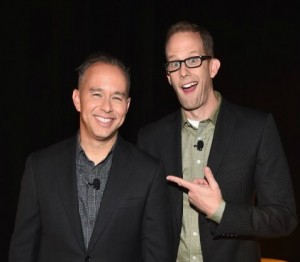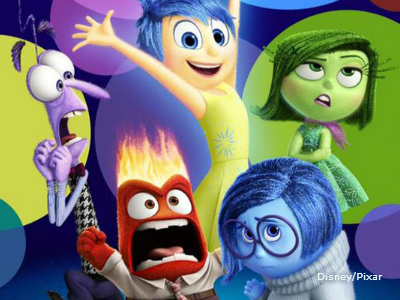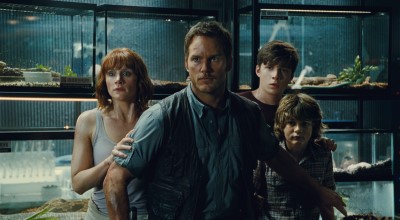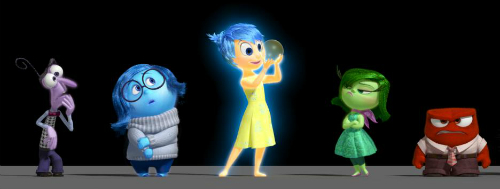
Recently, I got a chance to meet with two of Disney/Pixar’s most animated characters in an intimate round table discussion of their newest flick, Inside Out. Across from me sat Pete Docter, who is not only the vice president of creative at Pixar Animation Studios, but he also wrote and directed Inside Out. He’s been with Pixar since 1990 with his first assignment helping to develop the story and characters for Toy Story. Next to him was producer Jonas Rivera who joined Pixar in 1994 as the company’s first intern. After all these years, they are still in love with the company. They call themselves Disneylanders as they love the theme parks as much as we do. Together, they have been working on their latest project for five years, which is a long time to be talking about your feelings.
The woman next to me asks the first question to the pair: “How was the concept for this film born?”
“Well, it was sort of born thinking about emotions as characters. I was just doing a mind exercise like what would be fun to play with and emotions seemed like what animation does best, which is [show] strong opinionated like characturized personalities,” says Docter. “About that time, my daughter was eleven and she was going through a big kind of change as kids do from playing around on the ground with dolls to a little more quiet, so that change made me kind of wonder what was going on inside her head and maybe we could explore that a little bit.” This wasn’t the first time that Docter used his own flesh and blood for inspiration. His daughter’s personality and voice was used forYoung Ellie in UP.
“When [Pete] pitched [the idea] to me, I thought, this is a really great opportunity and a great arena to try to develop a movie,” says Rivera. “It felt like something that was familiar but foreign at the same time. No one has seen these things but probably thought about anger and dreams and…you know, things like that.”
When I saw the film, I was surprised that when the credits rolled, many of the other reviewers in the room were wiping their eyes. The film has a great message, but it seemed to hit home with some harder than others. I asked the film’s creators if they were surprised by these kinds of reactions.
“I am pleased that they are. Surprised? I’m always surprised that this stuff works – not that I don’t trust in it, but that we get so close to it that it is hard to judge, says Rivera.

“Watching it over a course of five years, you see it go from completely broken and not working to slowly finding [its way],” adds Docter. “By the end, you sort of find that the system has put it through enough hoops to really road test it. That doesn’t mean that there are any guarantees that the public will like it. That’s out of our control. It’s always gratifying. Obviously, you want laughs, but I almost feel a deeper understanding of what it is that I’m talking about when you see people emotionally moved.”
I then got a chance to talk about the pair’s personal faith knowing that Docter is a devout Christian. Rivera tells me that he is a fair-weather Catholic at best. I ask if their faith ever causes conflict in their work.
“Not really. I almost feel that the most effective stuff is when it’s not too preachy,” says Docter. “A lot of Christian folks have said, ‘When are you going to make like a real Christian film?’ and I’m like, ‘That’s not really the way to go about it.’ I feel like who I am kind of comes out in the work and what you believe comes out in your actions, you know, so, hopefully that’s not too round about…”
I assure him that I agree with what he was saying, but I pressed further wanting to know if they ever have to tell the studio or whomever “No, we don’t feel comfortable with that content” or something similar.
“No. I think though that there is kind of a mix of belief systems at work, but I feel like the gospel, if you will, of Pixar is really about community. All the films, if you look at them, are about someone who feels like they are on the outside in some way and reconnecting with a group and redefining their family,” Docter explains. “In a way, I think that’s our story. I was a nerd and didn’t fit in with anybody in high school and felt like I went a long time without any close friends. Then you get to a place like Pixar and everyone else knows Chuck Jones cartoons and quotes from Peanuts comic strips… so this feel sort of reflects our own craving for community and closeness and so I think there’s never been any problems that you’re talking about.”
However, Rivera has a different take on the subject “We have noticed that it does feel that some of the reviews for films like Brave were compared to our other films. So they’ll say, ‘It’s really great. It’s not as great as their others.’ That’s funny. I never see that for a Warner Bros. review like ‘that’s a great Warner Bros. film, not the best Warner Bros. movie but…”
The two see this criticism as a good thing. “We have a brand and there’s an expectation and we’ll take that. And that’s fair. We don’t make [movies] expecting everyone to like them all the same or all equal. We don’t put this one out there and hope that it’s better than UP or say something like ‘I hope that it makes more money.’ We just hope that it makes enough money so that they’ll let us make another one,” says Rivera.
Docter adds“On one level, it’s made us appreciate where we’ve been. We had such an unbelievable run from Toy Story to wherever you want to draw the line of critical audience and monetary success – it just kind of had everything and it wasn’t easy, but I think it makes you appreciate how special and unique it is when it does work. If you were to write a book about it, there have been about three or so phases of the feeling from inside the early days of Toy Story and A Bug’s Life…it felt like a garage. People doing it just for fun. And then kind of falling into a bit more rhythm and now it’s gotten bigger. I guess my point with all that is that it’s changed several times over a course of 25 years.”
Rivera nods in agreement. “I would say though that it hasn’t changed in how we develop things. It starts with a great volley and sort of a nugget of an idea. Although that the company has scaled up – it’s enormous now with 1,200 people from the 110 we had at Toy Story, I’m really proud that it’s retained that spirit and DNA. We know a little more about the world, but we just going to focus on what we do and keep going.”
Before our time was up, the two shared with us a few of the hidden Easter eggs in the film. For one, the Pizza Planet truck from Toy Story shows up about three times “very well disguised” says Docter and then Rivera, almost giddy, explains that there is a hidden portrait of the character Figment from the EPCOT attraction, “Journey to Imagination.” Finally, there is a nod to the next Disney/Pixar film, The Good Dinosaur which is coming to theaters around Thanksgiving.

